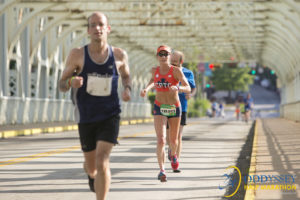
Around mile 10.5, coming over Falls Bridge.
As my first of 16 weeks into marathon training came to an end, I decided to take my first long run to a race course. My program called for a 13-miler, with the final 5 miles at Marathon Goal Pace. Negative-split runs aren’t easy, especially long runs. With other runs out there, and fluid stations every 1-2 miles, I decided a race would be a slightly easier way to focus on this first long run, practice hydrating with cups, and pacing myself amongst a crowd. So I hopped into the Oddessey Half Marathon, in Fairmount Park, Philadelphia.
The Oddessey Half is a race capped at about 3000 runners. It’s well organized, clearly marked, and there’s a pretty great Beer Garden at the finish line – courtesy of Sly Fox Brewing Company. The course has some pancake-flat miles, and some super extreme hills. It offers a little bit of everything. It also offered soup-like humidity. The predicted thunderstorms for Saturday night that would have swept the humidity away never showed, so when I stepped outside at 5am, it was a sticky,80+ degrees, with humidity over 75%. An additional challenge.
It was a good thing the race started at 7am, as every minute counted – temperature and sun intensified with every mile. While some miles had ample tree coverage and shade, other miles were in full-blown sunshine.
With the extreme humidity, I made an executive decision to adjust my plan and run the 5 marathon-paced miles at the beginning of the run. This turned out to be a smart move. I maintained Marathon Goal Pace for about 8 miles because I was feeling really good, and then allowed my body to slow down a bit. The humidity began to grind at my gears, and so I willingly let pace go. After all, this was supposed to be a long run and not my race.
Running with other runners is always an education. I’ve learned so much about myself as an athlete, being patient on the course, and how to run and race smart. I used the athletes around me to push the pace in the humidity for those first 5 miles, and then I willingly allowed runners to drop me and make their own choices while I did my own thing. Instead I focused on my form and efficiency, and spent moments observing other runners out there. I did more passing between miles 4-10 then I expected, including about a half dozen ladies who had gone out fast. As I gained on them, I could tell they were hurting. You can learn so much by a runner’s stride, form, and breathing. You can tell if that person will try to hang onto you or willingly let you go. I passed my final female around mile 9, putting me in 4th position. I never saw another lady out there for the remainder of the race.
Humidity is extremely humbling. Few runners handle it well, and for me it’s usually a matter of time before my body crumbles. Around mile 10, I remember my head feeling hot. I also remember my pace drastically dropping by about 15-25 seconds per mile. My quads began to feel like cement bricks, and my feet began to lose their quick and powerful contact with the ground. Instead I could feel every stride becoming heavy and slow. Dehydration was becoming an issue, and I was ready to be done. That final 5K was a grind, and some of it in full sunshine. The final mile of the Oddessey is a pretty epic climb – you run down it around mile 3, so you know what you have in your future. That hill had no shade. When I finally made the turn off of MLK Drive and to the hill, I was glad to be so close to the finish, but also dreading the abuse my tanked quads would take. I tried to relax, but even as my pace slowed, it was a struggle. My right calf felt as though it was going to cramp a few times, which is rare for me. So I did something I rarely do – I walked part of the hill. Yes, I stopped running and power-walked up part of the hill. I didn’t care if 10 females were about to pass me. I kept telling myself to be smart. This was a training run. I had a track workout on my calendar for 48 hours in the future. I needed to make good choices. So I did a walk/run negotiation, which probably was not expected for 4th Place Female, but there you have it.
The final quarter mile is flat, and I just let my body lead. A runner near me asked to kick with him, and though tempted, I refused and told him to drop the hammer. Again, not my race. Just a run. A run I was VERY happy to be finished with. I crossed the finish line tired, dehydrated, and happy at my pacing and decisions.
I waited at the Beer Garden, drinking a few pints and chatting with runners as we cheered in other finishers. Multiple runners collapsed on the final stretch, needing medical attention. Two were taken away in ambulances. On the course a runner dropped out and needed medical attention near me around mile 5. Watching runners in serious destress made me even happier with my decision to run smart, hydrate often, and respect the weather. Some days we learn lessons the hard way. I’m glad this was I day I didn’t need to.



